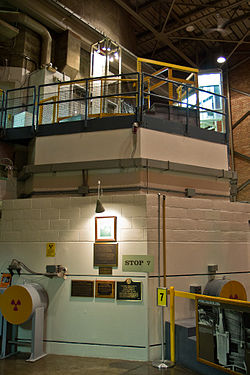EBR-1
|
Experimental Breeder Reactor No. 1
|
|

Experimental Breeder Reactor Number 1 in Idaho, the first power reactor.
|
|
| Location | Butte County, Idaho, US |
|---|---|
| Nearest city | Arco, Idaho |
| Coordinates | 43°30′41″N 113°00′23″W / 43.51132°N 113.0064°WCoordinates: 43°30′41″N 113°00′23″W / 43.51132°N 113.0064°W |
| Built | 1950 |
| Architect | Atomic Energy Commission |
| NRHP Reference # | 66000307 |
| Significant dates | |
| Added to NRHP | October 15, 1966 |
| Designated NHL | December 21, 1965 |
Experimental Breeder Reactor I (EBR-I) is a decommissioned research reactor and U.S. National Historic Landmark located in the desert about 18 miles (29 km) southeast of Arco, Idaho. At 1:50 p.m. on December 20, 1951, it became one of the world's first electricity-generating nuclear power plants when it produced sufficient electricity to illuminate four 200-watt light bulbs. Electricity had earlier been generated by a nuclear reactor on September 3, 1948 at the X-10 Graphite Reactor in Oak Ridge, Tennessee. EBR-I subsequently generated sufficient electricity to power its building, and continued to be used for experimental purposes until it was decommissioned in 1964.
As part of the National Reactor Testing Station (now Idaho National Laboratory), EBR-I's construction started in late 1949. The reactor was designed by a team led by Walter Zinn at the Argonne National Laboratory. In its early stages, the reactor plant was referred to as Chicago Pile 4 (CP-4) and Zinn's Infernal Pile. Installation of the reactor at EBR-I took place in early 1951 (the first reactor in Idaho) and it began power operation on August 24, 1951. On December 20 of that year, atomic energy was successfully harvested for the first time. The following day, the reactor produced enough power to light the whole building. The power plant produced 200 kW of electricity out of 1.4 MW of heat generated by the reactor.
The design purpose of EBR-I was not to produce electricity but instead to validate nuclear physics theory which suggested that a breeder reactor should be possible. In 1953, experiments revealed the reactor was producing additional fuel during fission, thus confirming the hypothesis. On November 29, 1955, the reactor at EBR-I suffered a partial meltdown during a coolant flow test. The flow test was trying to determine the cause of unexpected reactor responses to changes in coolant flow. It was subsequently repaired for further experiments, which determined that thermal expansion of the fuel rods and the thick plates supporting the fuel rods was the cause of the unexpected reactor response.
...
Wikipedia


